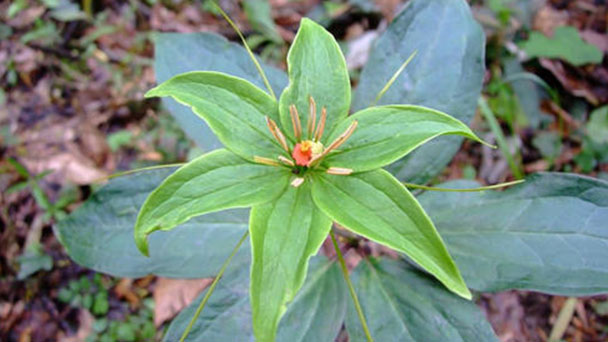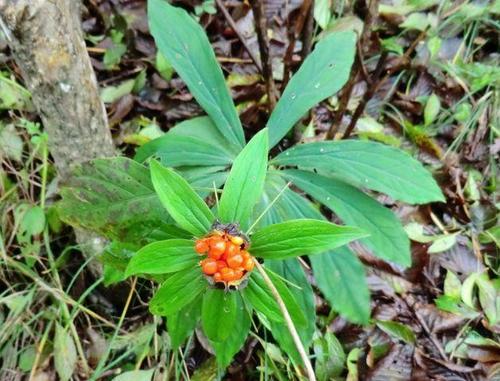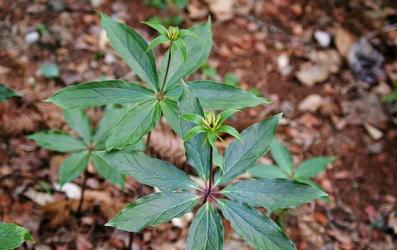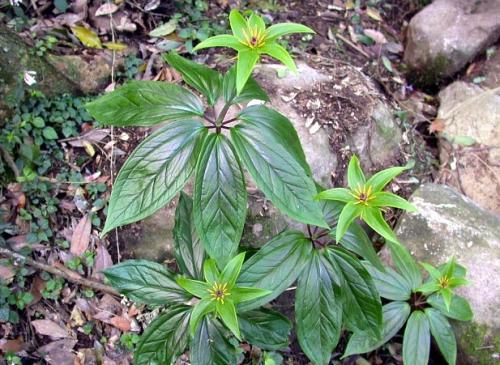Paris polyphylla profile
Written by admin
Aug 31 2021

Paris polyphylla is heterogeneous in plants, its biggest feature is composed of a circle of leaves of the whorl of a flower. Paris polyphylla is not rare, rare is the flower like the shape of its leaves. Paris polyphylla can be divided into two parts, ocean shipping flowers, and the inner ocean shipping flowers and leaves, about six pieces, and the inner about eight pieces of flowers, let you can see at a glance. As for the whorled leaves of Paris Polyphylla, do they have to be made of seven? The answer is no.
Paris polyphylla picture

Morphological characteristics of Paris polyphylla
Paris Polyphylla is a perennial herb with 6 to 10 whorled leaves, petioles 5 to 20mm long, leaves thick papery, lanceolate, ovate-oblong to obovate, 5 to 11cm long and 2 to 4.5cm wide. Pedicels drawn from apex of stem, terminal to a flower; Flowers of paris polyphylla are bisexual, sepals lanceolate or ovate, green, 3.5 -- 6cm long; Perianth segments linear to slightly lanceolate, yellow, about 1/2 to subequal of sepals above middle, 2 -- 6mm wide; Paris polyphylla has 8-10 stamens, anthers 1 -- 1.5cm long, filaments shorter than anthers, septum protruding 1 -- 2mm.Born under the mountain forest or roadside grass in the damp. Mining can be excavated throughout the year, but it is better to autumn mining, drying or slice drying.
Paris Polyphylla is 50-100 cm tall. Rhizome is stout, conical or terete, up to 3 cm thick, with many annular nodules, brown, with many fibrous roots. Stem is erect, terete, unbranched, often purplish at base. Paris polyphylla has 7-10 leaves, rotund on apex of stem, oblong, elliptic, or ovate-lanceolate, 7-15 cm long, 2.5 -- 5 cm wide, apex acute or acuminate, base rounded, thinly cuneate, entire, glabrous; Petioles of Paris polyphylla are 2 -- 5 cm long usually purplish.
Flowers of Paris polyphylla are solitary at stem apex, upper whorled leaf blade; Pedicels are 5-16 (30) cm long; Outer perianth segments (sepals) are 4 -- 6, large, leaflike, elliptic-lanceolate or ovate-lanceolate, green, 3.5 -- 8 cm long, inner perianth segments (petals) reduced linear, apex often acuminate, equal to or twice as long as sepals; Paris polyphylla has 8-12 stamens, filaments subequal to anthers, connective bulges 0.5-1⑵ mm long; Ovary is conical, 5-6-rowed; Styles are stout, 4-6, purple, capsule subglobose, 3-6 lobed.
How to grow and care for Paris polyphylla
1. Ambient temperature
Paris Polyphylla is a hardy plant, which is generally free from freezing at low temperatures. The temperature from late February to early March was 5℃, and there was no freezing damage to bud heads when the temperature was 1 ~ -2℃.
2. Soil care
The soil used in Paris Polyphylla cultivation can be a mixture of peat soil, leaf rot soil with about 1/3 of perlite and a small amount of base fertilizer. It can also be potted with fine sand soil.
3. Lighting care
When curing Paris Polyphylla, it usually needs about 4 hours of direct sunlight every day. Adequate sunlight can make Paris Polyphylla grow well.
4. Watering care
Paris Polyphylla likes a cool, wet and moderately watery environment. It is afraid of both drought and water, so it will water differently according to different seasons.
The amount of water you water will vary depending on the season, but you generally need more water in the summer, so water once a day to keep the pot soil moist.
In the spring and autumn season every 3 ~ 4 days watering once, in addition to watering to control the amount, if too much watering or waterlogging, easy to cause Paris Polyphylla root rot.
5. Fertilization care
Summer is the growing season of Paris Polyphylla, so it is necessary to apply fertilizer once a week. In general, fertilizer can be applied with granular fertilizer of nitrogen, phosphorus and potassium after loosening the soil.
6. Pest control
Paris Polyphylla has common diseases such as leaf spot and anthrax, and common pests such as scale insects, red spiders, thrips and leaf poplars, so pest control measures should be taken in the maintenance.
Paris polyphylla sowing propagation
Paris Polyphylla likes a cool, damp environment. Paris polyphylla is suitable for rich sandy loam or humus loam planting. Propagate with seeds and rhizomes. Seed propagation, autumn seed maturity is, with the harvest with sowing, drill or broadcast, covering soil 4~5 minutes. Cultivate 2-3 years of village or late autumn transplantation. Rhizome propagation is to harvest at the time, cut off the bud tip of 3~5 segments, ditch planting, row spacing of 8*4 inches.
Weeding and watering should be done during the growth of Paris Polyphylla. Top dressing can be carried out after the emergence of seedlings in the next spring, with nitrogen and phosphate fertilizer as the main fertilizer. Collection and processing of wild summer, autumn mining. Cultivation after 3~5 years of late autumn on the ground after wilting is excavated. Wash and slice and dry in the sun.

Variety classification of Paris Polyphylla
Many of the same plants have thick and thick rhizomes, and their effects are similar to those of the first two. Hereby, the widely distributed plants are listed as follows:
1. Paris Polyphylla Smith var. yunnanensis (Franch.) Hand. -mazz. It is distinguished from Paris Polyphylla by the wedge-shaped leaf base. Petals are as long as or equal to calyx, 2 -- 3 mm wide, rarely 4 or 1 mm. It is distributed in Sichuan, Guizhou, Yunnan and other provinces.
2, Paris Polyphylla Smith var. platypetala Franch. Leaf base suborbicular; Petals much shorter than calyx, broadened near the apex, 2 -- 4 mm wide in the middle or above. It is distributed in East China, South China, Southwest China and Hubei Province.
3. Paris Polyphylla Smith Var. Stenophylla Franch. Leaves usually 10 -- 22, narrowly lanceolate, or long, 3 -- 25 mm wide, sessile or shortly stipitate; Anthers septum protrusion ca. 1/2 mm long. It is distributed in East China, Central and South China, Southwest China and Shanxi, Shaanxi, Gansu and other provinces.
Leaves 7 to 9, sessile or short stipitate, broadly lanceolate or long elliptic; Pedicels shorter than leaves, petals about 1 -- 1.5 mm wide, distributed in Hunan, Hubei, Sichuan, Guizhou, Yunnan, Xizang and other provinces.
4. Paris Fargesii Franch. Leaves long stalk, ovoid, base cordate; Anthers connective protruding part hypertrophic, fleshy, globose or subglobose; Petal less than half of calyx.It is distributed in Jiangxi, Guangdong, Hubei, Sichuan, Guizhou and other provinces.
5. Paris Fargesii Franch. Var. Petiolata (Baker ex C. H. Wright) Wang et Tang, leaves petiolate, rounded to oblong-ovate, base often heart-shaped; Petal equal to or less than half of calyx. It is distributed in Jiangxi, Guangxi, Sichuan, Guizhou and other provinces.
6. Paris Thibetica Franch. Leaves 7-12, lanceolate or oblanceolate, mostly sessile;Anther connective protrusion conspicuously elongated, 6 -- 16 mm long, rarely shortened to 3 mm. It is distributed in Sichuan, Guizhou, Yunnan and other provinces.
The distribution of Paris Polyphylla
Paris polyphylla is a genus of plants in the family Liliaceae.It is distributed in Bhutan, Vietnam, Sikkim, Nepal, Taiwan and Guizhou, Yunnan, Xizang and Sichuan provinces of mainland China. Paris polyphylla grows at an altitude of 1,800 meters to 3,200 meters. It is generally born under forests and has not been artificially introduced and cultivated.

Latest Updated
- Benefits of Bugleweed - 7 Science-backed Health Benefits
- Bugleweed Dangers & Side Effects - Is It Poisonous?
- How to Plant Evergreen Trees - What You Should Know
- When to Plant Evergreens - Grow Guide for Evergreen Trees
- 12 Wonderful Evergreen Shrubs for Your Garden
- 12 Popular Evergreen Plants with Pictures for Beginners
- When And How To Prune A Lilac Bush Like a Pro
- How to Grow & Care for Lilac Vine (Hardenbergia Violacea)
- Japanese Lilac Tree (Syringa Reticulata) Care & Propagation Guide
- Shumard Oak Pros and Cons - What to Know
Popular Articles
- Winter maintenance of Antirrhinum Majus
- How to Grow Terminalia Mantaly Tree
- How to Grow and Care for Crossostephium Chinense
- How to grow Antirrhinum Majus in spring
- Peristeria Elata (Dove Orchid) Profile: Info & Care Guide
- Underwatered Snake Plant (Sansevieria Trifasciata) - Signs And How To Fix
- How to Care for Brazilian Jasmine Plant (Mandevilla Sanderi)
- How to Grow & Care for Graptopetalum Purple Delight in Summer
- Rosa Chinensis (China Rose): Plant Growing & Care Tips
- How to Care for Baby Sun Rose (Aptenia Cordifolia)